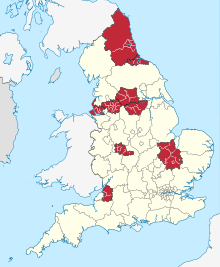Combined authority
A combined authority is a type of local government institution introduced in England outside Greater London by the Local Democracy, Economic Development and Construction Act 2009.
 |
|---|
| This article is part of a series on the politics and government of England |
|
Elections |
|
|
|
|
There are currently ten such authorities, with the Greater Manchester Combined Authority established on 1 April 2011, four others established in April 2014, two in 2016, two more in 2017 and one in 2018. Combined authorities are created in areas where they are considered likely to improve transport, economic development and regeneration. Combined authorities are created voluntarily and allow a group of local authorities to pool appropriate responsibility and receive certain delegated functions from central government in order to deliver transport and economic policy more effectively over a wider area.
History
Following the abolition of metropolitan county councils and the Greater London Council in 1986, England had no local government bodies with strategic authority over the major urban areas of the country. In 1999, following a successful referendum, the Labour government created a strategic authority for London (the Greater London Authority), but no bodies were established to replace the metropolitan county councils outside London. The Blair government instead pursued the idea of elected Regional Assemblies, although following an unsuccessful referendum in 2004 in the most positive region – the North East – this idea had few proponents. The idea of city regions was proposed subsequently.
In October 2010 the Coalition Government introduced measures to replace Regional Development Agencies, which were described as inefficient and costly.[1] They were replaced with local enterprise partnerships, voluntary groups with membership drawn from the private sector with local authority input.
Earlier in 2010 the Government accepted a proposal from the Association of Greater Manchester Authorities to establish a Greater Manchester Combined Authority as an indirectly elected top-tier strategic authority for Greater Manchester.[2] Following the unsuccessful English mayoral referendums in 2012, combined authorities have been used as an alternative means to grant additional powers and funding as part of 'city deals' to metropolitan areas. In 2014, indirectly elected combined authorities were established for the metropolitan counties of South Yorkshire and West Yorkshire, and two combined authorities were established which each covered a metropolitan county and adjacent non-metropolitan districts: the Liverpool City Region Combined Authority for Merseyside and the Borough of Halton unitary authority, and the North East Combined Authority for Tyne and Wear and the unitary authorities of County Durham and Northumberland. In 2016 a combined authority was formed for the metropolitan county of the West Midlands, so that all metropolitan counties are now covered by combined authorities.
The first combined authority that does not cover a metropolitan county was Tees Valley, formed in 2016. It covers the area of the former county of Cleveland (now four unitary authorities in the ceremonial counties of Durham and North Yorkshire), together with the unitary authority of Darlington. Two further combined authorities were formed in 2017: West of England, comprising Bristol and two of the three adjacent unitary authorities in Gloucestershire and Somerset; and Cambridgeshire and Peterborough.
Legislation
The Local Democracy, Economic Development and Construction Act 2009 allowed for certain functions over transport to be delegated from central government. The Localism Act 2011 allowed additional transfers of powers from the Secretary of State for Communities and Local Government and gave combined authorities a general power of competence.[3][4] The powers and functions to be shared are agreed by the metropolitan district, non-metropolitan district, non-metropolitan county or unitary authority councils.
In 2014 the government consulted on changes to the legislation governing combined authorities. Proposed changes included extending the legislation to Greater London, Wales and Scotland.[5] The Cities and Local Government Devolution Act 2016 received Royal Assent on 28 January 2016.[6] The act allowed for the introduction of directly elected mayors to combined authorities in England and Wales with powers over housing, transport, planning and policing.[7]
Powers and functions
The combined authority is a legally recognised entity able to assume the role of an integrated transport authority and economic prosperity board. This gives the combined authority the power to exercise any function of its constituent councils that relates to economic development and regeneration, and any of the functions that are available to integrated transport authorities. For transport purposes combined authorities are able to borrow money and can levy constituent authorities.
Combined authorities are encouraged to borrow from European institutions for social and environmental schemes which meet EU objectives. Loans are made with conditions attached which further EU policies. By 2015 Greater Manchester CA had agreed loans from the European Investment Bank which topped £1 billion,[8] with similar liabilities to the Treasury and private business.
Process of creation or amendment
Combined authorities consist of two or more contiguous English local government areas. The creation of a combined authority is voluntary and all local authorities within the area must give their consent before it can be created.[9] The local authority of any district of England outside Greater London can join a combined authority, and a county council can become part of a combined authority even if only some of the non-metropolitan districts that make up the county are within the combined authority area. A local authority may only belong to one combined authority.[10]
There are three stages to the creation or amendment of a combined authority. Firstly a review must be undertaken to establish the likelihood that a combined authority would improve:
"...the exercise of statutory functions relating to transport in the area, the effectiveness and efficiency of transport in the area, the exercise of statutory functions relating to economic development and regeneration in the area, and economic conditions in the area."
— Local Democracy, Economic Development and Construction Act 2009, Part 6[11]
On completion of the review the local authorities produce and publish a proposed scheme of the combined authority to be created, including the area that will be covered, the constitution and functions. This will include details of membership of the authority, remuneration, and how meetings will be chaired and recorded. Following a period of consultation and subject to the approval of the Secretary of State for Communities and Local Government, the combined authority is formally created, dissolved or altered by a statutory instrument.
Existing combined authorities

Following the unsuccessful English mayoral referendums in 2012, new combined authorities were encouraged as an alternative structure to receive additional powers and funding as part of 'city deals'.[12] The combined authorities that have been created are as follows.[13]
Proposed combined authorities
It is proposed that the following combined authorities should be created:
| Area | Status |
|---|---|
| Cheshire East, Cheshire West and Chester and Warrington have proposed the formation of a Cheshire and Warrington Combined Authority. | Proposals underwent a public consultation in Summer 2017[23] but government permission was still being sought in Spring 2020.[24] |
| Councils in Devon and Somerset have proposed the formation of a Heart of the South West Combined Authority. | Talks between local councils ongoing, combined authority model approved in principle.[25] |
| Dorset Combined Authority. | A combined authority was initially proposed by the county's nine constituent councils, and is being considered by the two unitary councils which replaced them in April 2019.[26][27] |
| Leicester and Leicestershire Combined Authority. | Awaiting agreement of local councils.[28] |
Proposals not implemented
Proposals for a number of combined authorities have not been undertaken due to the required approval from some participating local councils not being received:
- Cumbria[29]
- East Anglia (although the Cambridgeshire and Peterborough element went ahead)[30]
- Essex[31]
- Greater Lincolnshire[32]
- Heart of Hampshire[33]
- Lancashire[34]
- Norfolk and Suffolk[35]
- North Midlands[36]
- One Yorkshire[37]
- Solent[38]
References
- "Local Enterprise Partnerships white paper" (PDF).
- "John Denham – Greater Manchester to be country's first ever Combined Authority". The National Archives. The Department of Communities and Local Government. 31 March 2010. Archived from the original on 4 May 2010. Retrieved 15 November 2015.
Historic plans for the country's first ever Combined Authority covering the whole of Greater Manchester to drive locally the region's economic growth were launched by Communities Secretary John Denham today.
- "A plain English guide to the Localism Act" (PDF). Department for Communities and Local Government. November 2011. Retrieved 15 December 2015.
- "Combined Authorities" (PDF). House of Commons Library. 9 October 2015. Retrieved 15 December 2015.
- Marrs, Colin (11 September 2014). "London seeks combined authority powers". Room 151: Local Government Treasury, Technical and Strategic Finance. Retrieved 2 June 2015.
- "Bill stages — Cities and Local Government Devolution Act 2016". Parliament of the United Kingdom. Archived from the original on 5 March 2016. Retrieved 12 March 2016.
- "Cities and Local Government Devolution Act 2016". The Stationery Office. Retrieved 12 March 2016.
- "Search engine".
- "Economic prosperity boards and combined authorities: Consultation on draft statutory guidance" (PDF). Archived from the original (PDF) on 24 August 2012. Retrieved 11 August 2012.
- "Combined Authorities Briefing: Stronger Together?". 5 July 2012. Archived from the original on 3 August 2012. Retrieved 11 August 2012.
- "Local Democracy, Economic Development and Construction Act 2009". Retrieved 11 August 2012.
- Sergeant, Mike. "Six biggest English cities get extra powers – BBC News". Bbc.co.uk. Retrieved 2015-09-07.
- "Cities' economic power unlocked in radical power shift". 5 July 2012. Retrieved 11 August 2012.
- "Population dynamics of UK city regions since mid-2011". Office for National Statistics. 12 October 2016.
- "The Cambridgeshire and Peterborough Combined Authority Order 2017", legislation.gov.uk, The National Archives, SI 2017/251
- "The Greater Manchester Combined Authority Order 2011". Retrieved 11 August 2012.
- "The Halton, Knowsley, Liverpool, St Helens, Sefton and Wirral Combined Authority Order 2014".
- "The Barnsley, Doncaster, Rotherham and Sheffield Combined Authority Order 2014".
- "The Tees Valley Combined Authority Order 2016". Statutory Instrument No. 449 of 29 March 2016.
- "The West of England Combined Authority Order 2017", legislation.gov.uk, The National Archives, SI 2017/126
- "The West Yorkshire Combined Authority Order 2014".
- "The Durham, Gateshead, Newcastle Upon Tyne, North Tyneside, Northumberland, South Tyneside and Sunderland Combined Authority Order 2014" (PDF).
- "Warrington to join Cheshire devolution bid". BBC News. 2017-02-14. Retrieved 2017-03-05.
- Andy Bounds (11 March 2020). "£38m a year for a greater West Yorkshire". Financial Times.
- Andy Keeble (2017-01-17). "Councils are 'keeping a foot in the door' on Devon and Somerset devolution deal". North Devon Gazette. Retrieved 2017-03-05.
- "Speed up Dorset combined council plan, MP urges". BBC News. 2017-01-17. Retrieved 2017-03-05.
- "New Dorset unitary councils consider combined authority". BBC News. 18 January 2019.
- Megan Cox (2016-11-22). "Constitution agreed for combined authority". Loughborough Echo. Retrieved 2017-03-05.
- "Cumbria's rejection of devolution deal costing Copeland millions of pounds, says mayor". News & Star. 2017-01-30. Retrieved 2017-03-05.
- Joel Lamy (2016-04-13). "Devolution between Peterborough and Cambridgeshire to be discussed after widespread city council opposition to East Anglian authority". Peterborough Telegraph. Retrieved 2017-01-18.
- "Council leaders in Essex vote against elected mayor with authority over south Essex". Thurrock Gazette. 2016-06-08. Retrieved 2017-03-05.
- Stefan Pidluznyj (2016-11-11). "Scrapped: Lincolnshire's £450m devolution deal no more". The Lincolnite. Retrieved 2017-01-14.
- "Unity call as devolution 'dead in the water'". Alton Herald. 2017-02-11. Retrieved 2017-03-05.
- Stevens, Mike (1 December 2017). "Lancashire devolution plans collapse". BBC News: Lancashire. Retrieved 25 December 2017.
- "Norfolk and Suffolk elected mayor plans scrapped". BBC News. 2016-11-18. Retrieved 2017-01-14.
- Jennifer Scott (21 July 2016). "Devolution is dead – so what is the plan for Nottingham's future?". Nottingham Post. Retrieved 14 February 2017.
- "Government rejects 'One Yorkshire' devolution deal'". BBC News. 2019-02-12. Retrieved 2019-08-09.
- "Solent Combined Authority bid 'almost certainly dead'". BBC News. 2017-01-26. Retrieved 2017-03-05.
External links
- House of Commons Library Briefing Paper, July 2017